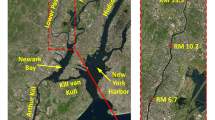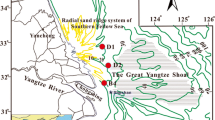Abstract
A proper understanding of the bottom dynamic conditions (erosion, transportation, accumulation) in lakes is essential in most sedimentological contexts. Fine cohesive materials generally dominate the open water areas, whereas coarser deposits (sand, gravel) dominate shallow regions where erosion and transportation of fine materials prevail. At present, there is no physical model available which describes the linkage between the energy content of the water-mass and the capacity for sediment entrainment in open water areas. Water-mass energy depends on, e.g. wind direction, duration, velocity, fetch, and the presence of a thermocline. Entrainment depends on, e.g. density, compaction, water and organic content of the sediments and the number and type of bottom fauna.
Four different methods are used to determine bottom dynamics, two aresite typical and two arelake typical.Site andlake typical methods each include one method based on collected field data and one based on theoretical data. One method, the cone apparatus, is presented for the first time. It consists of two cones, one of which has a narrow angle and the other a wide angle, which are zero adjusted at the sediment surface before being released to penetrate the sediments. The differential cone penetration, refered to as the penetration ratio, is used to indicate the degree of surficial sediment compaction. This simple, inexpensive instrument provides quantitative data on physical sediment characteristics which may be related to bottom dynamic conditions.
Similar content being viewed by others
References
Axelsson, V., 1967. The Laitaure delta. A study of deltaic morphology and processes. Geogr. Ann. 49: 1–127.
Axelsson, V. & Håkanson, L., 1975. The relation between mercury distribution and sedimentological environment in Lake Ekoln. Part 4. Deposition of sediment and mercury in 1971 and 1972. UNGI Rapport 35, Univ. of Uppsala. 42 pp.
Bagnold, R. A., 1954. The Physics of Blown Sand and Desert Dunes. Methuen, London. 165 pp.
Beach Erosion Board, 1972. Waves in inland reservoirs. Techn. Mem 132, Beach Erosion Corps of Engineers, Washington, D.C. 125 pp.
Blomqvist, S., 1981. Fysikalisk bottendynamik. Underlag för råd och riktlinjer av muddring och muddertippning. Preprint in Swedish, Nat. Swe. Env. Prot. Bd., Stockholm. 11 pp.
Fischer, H. B., List, E. J., Hoh, R. C. Y., Imberger, J. & Brooks, N. H., 1979. Mixing in inland and coastal waters. Academic Press, New York. 483 pp.
Fisher, J. S., Pickral, J. & Odum, W. E., 1979. Organic detritus particles: initiation of motion criteria. Limnol. Oceanogr. 24: 529–532.
Förstner, U. & Wittmann, G. T. W., 1979. Metal Pollution in the Aquatic Environment. Springer-Verlag, Berlin. 486 pp.
Gilbert, R., 1975. Sedimentation in Lillooet lake, British Columbia. Can J. Earth Sci. 12: 1697–1711.
Gilbert, R. & Shaw, J., 1980. Sedimentation in proglacial Sunwapta lake, Alberta. Can. J. Earth Sci. 18: 81–93.
Håkanson, L., 1975. Mercury in Lake Vänern — present status and prognosis. SNV PM 563, Nat. Swe. Env. Prot. Bd, Uppsala. 121 pp.
Håkanson, L., 1977a. The influence of wind, fetch, and water depth on the distribution of sediments in Lake Vänern, Sweden. Can. J. Earth Sci. 14: 397–412.
Håkanson, L., 1977b. An empirical model for physical parameters of recent sedimentary deposits of Lake Ekoln and Lake Vänern. Vatten 3: 266–239.
Håkanson, L., 1981a. Determination of characteristic values for physical and chemical lake sediment parameters (Accepted by Water Resources Research).
Håkanson, L., 1981b. On lake bottom dynamics — the energy-topography factor. Can. J. Earth Sci. 18: 899–909.
Håkanson, L., 1981c. Lake sediments in aquatic pollution control programs: principles, processes and practical examples. SNV PM 1398, Nat. Swe. Env. Prot. Bd, Uppsala. 242 pp.
Håkanson, L., 1981d. A Manual of Lake Morphometry. Springer-Verlag, Berlin. 78 pp.
Hamblin, P. F. & Carmack, E. C., 1978. River-induced currents in a fjord lake. J. geophys. Res. 83: 885–899.
Hansebo, S., 1957. A new approach to the determination of the shear strength of clays by the fallcone test. R. Swe. Geol. Inst. Proc. Nr. 14, Stockholm. 47 pp.
Hjulström, F., 1935. Studies of the morphological activity of rivers as illustrated by the River Fyris. Bull. Geol. Inst. Uppsala 25: 221–527.
Johnson, T. C.,1980. Sediment redistribution by waves in lakes, reservoirs and embayments. In: Stefan, H. (Ed.) Proceedings of Symposium on Surface-Water Impoundments. American Society Civil Engineering (preprint).
Kemp, A. L. W., Anderson, T. W., Thomas, R. L. & Mudrochova, P., 1974. Sedimentation rates and recent sediment history of Lakes Ontario, Erie and Huron. J. Sed. Pet. 44: 207–218.
Kemp, A. L. W., MacInnis, G. A. & Harper, N. S., 1977. Sedimentation rates and a revised sediment budget for Lake Erie. Int. Ass. Great Lakes Res. 3: 221–233.
Lastein, E., 1976. Recent sedimentation and resuspension of organic matter in eutrophic Lake Esrom, Denmark. Oikos 27: 44–49.
Ludlam, S. D., 1974. Fayetteville Green Lake, New York. 6. The role of turbidity currents in lake sedimentation. Limnol. Oceanogr. 19: 656–664.
Lüthi, S., 1980. Some new aspects of two-dimensional turbidity currents. Sedimentology 28: 97–105.
McCall, P. L., 1979. The effects of deposit feeding oligochaetes on particle size and settling velocity of Lake Erie sediments. J. Sed. Pet. 49: 813–818.
McCall, P. L. & Fisher, J. B., 1980. Effects of tubificid oligochaetes on physical and chemical properties of Lake Erie sediments. In: Brinkhurst, R. O. & Cook, D. G. (Eds.) Aquatic Oligochaete Biology, pp. 253–317. Plenum Press, New York.
Moeller, R. E. & Likens, G. E., 1978. Seston sedimentation in Mirror Lake, New Hampshire, and its relationship to long-term sediment accumulation. Verh. int. Verein. Limnol. 20: 525–530.
Norrman, J. O., 1964. Lake Vättern. Investigations on shore and bottom morphology. Geogr. Ann. 46: 1–238.
Nydegger, P., 1976. Strömungen in Seen: Untersuchungen in situ und an nachgebildeten Modellseen. Beitr. Geol. Schweiz. Kl. Mitt. 66: 141–177.
Pharo, C. H. & Carmack, E. C., 1979. Sedimentation processes in a short residence-time intermontane lake, Kamloops Lake, British Columbia. Sedimentology 26: 523–541.
Sly, P. G., 1978. Sedimentary processes in lakes. In: Lerman, A. (Ed.) Lakes-Chemistry, Geology, Physics, pp. 65–89. Springer-Verlag, New York.
Sturm, M. & Matter, A., 1978. Turbidities and varves in Lake Briensz (Switzerland): deposition of elastic detritus by density currents. Spec. Publ. Int. Ass. Sediment. 2: 147–168.
Sundborg, å., 1956. The River Klarälven. A study of fluvical processes. Geogr. Ann. 38: 125–316.
Terwindt, J. H. J., 1977. Deposition, transportation and erosion of mud. In: Golterman, H. L. (Ed.) Interactions between Sediments and Fresh Water, pp. 19–24. Dr. W. Junk, The Hague.
Tutin, W., 1955. Preliminary observations on a year's cycle of sedimentation in Windermere, England. Mem. 1st. Ital. Idrobiol. Suppl. 8: 467–484.
Welch, P. S., 1948. Limnological Methods. The Blakiston Co., Philadelphia. 381 pp.
Wright, R. F. & Nydegger, P., 1980. Sedimentation of detrital particulate matter in lakes: influence of currents produced by inflowing rivers. Water Resources Res. 16: 597–601.
Author information
Authors and Affiliations
Rights and permissions
About this article
Cite this article
Håkanson, L. Bottom dynamics in lakes. Hydrobiologia 91, 9–22 (1982). https://doi.org/10.1007/BF02391918
Issue Date:
DOI: https://doi.org/10.1007/BF02391918




